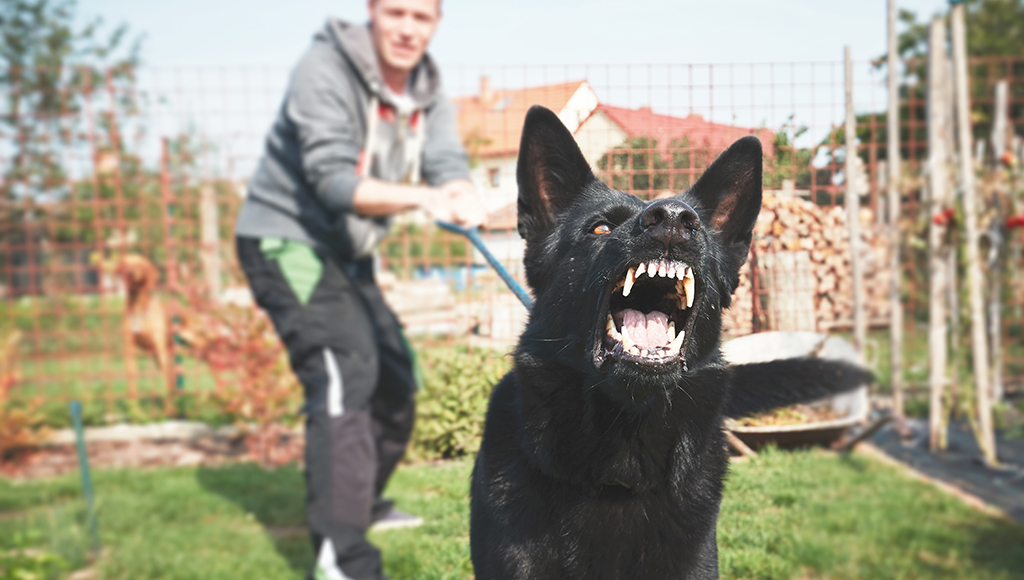Aggressive Dog Behavior
One of the most serious problems pet owners must deal with.

Aggression in dogs is the most serious behavior problem that pet
owners must deal with, and it is largely preventable if the owner
understands canine growth periods and the factors that can
influence the development of aggressive behavior.
Health authorities report that more than one million people are
bitten each year, but this number probably represents only half
the actual bites; the rest go unreported. Although many bite
wounds are minor, experts have reported that bites account for
one percent of all emergency room admissions and cost about $30
million in annual health care. At least half of dog bite victims
are young children, usually under 10 years of age.
Critical Periods of Socialization
Knowledge of the early growth periods of dogs is helpful in
understanding canine aggression. Puppies have a critical need for
socialization from as early as three weeks of age, when they can
see and hear, until 14 weeks of age. It’s a good idea to purchase
a puppy between seven and eight weeks of age for proper
socialization in the new home. Eight to 10 weeks is a fearful
period, during which the puppy must not be harshly disciplined
and must be handled gently by adults and children.
Fourteen weeks starts the juvenile period -- the dreaded
adolescence -- that ends when the pup achieves sexual maturity,
usually at about 14-15 months of age. If a puppy has not been
socialized by the time he is 14 weeks old, he may never be
trustworthy around people or other dogs.
Puppies raised in kennels where they receive very little human
handling will often remain shy of people, particularly if they
are not sold prior to 14 weeks of age. They may always be
fearful, especially under stressful conditions.
Dogs reach sexual maturity at six to 14 months of age. During
this period, they usually begin to bark at strangers and become
more protective, and males begin lifting a leg to urinate.
Introduction to strangers (adults, children, and other dogs) on
the home property during this period is important as well,
especially if the pup has missed out on early socialization.
Factors Influencing Aggression
Genetic and hereditary factors do play a major role in
aggression. Protective breeds such as Dobermans, Akitas, and
Rottweilers are expected to be more aggressive than Golden
Retrievers and Labrador Retrievers. Feisty terriers were bred to
kill small game, and this breed still retains this characteristic
today.
There are several factors that can contribute to unstable
temperaments and aggressive tendencies in dogs:
-
Environment -- living conditions
-
Lack of socialization
-
Excessive punishment
-
Being attacked or frightened by an aggressive dog
-
Being spoiled or given too much unwarranted praise by owners
-
Being isolated from human contact
-
Being exposed to frequent teasing by children
The subtle signs of dominance usually go unnoticed or are
explained away until the dog bites a human for infringement on
his alpha position. The owner misunderstands the progression of
behaviors and blames the dog for biting "for no reason." These
dogs frequently end up at animal shelters and are destroyed
because their owners misunderstood the development of aggressive
behavior.
Types of Aggression
There are several types of aggression: defensive or induced by
fear, pain, or punishment; dominant; possessive; territorial;
intra-sexual (male-to-male or female-to-female); predatory; or
parental. A dog may exhibit more than one type of aggression.
Dominant-aggressive dogs are characterized as confident and
macho. They stand tall, up on their toes, with their ears up and
forward. They carry their tails high and wag it slowly and
stiffly from side to side. They often have their hackles up,
stare menacingly, and emit a low growl with lips pursed and teeth
exposed. They will place a paw on the shoulder of another dog,
mount people's legs, and push children aside when going through a
door. Dominant-aggressive dogs are demanding of attention. They
demand to go outside, demand excessive affection, are possessive
of their sleeping areas, and stop eating when approached. Many of
these dogs will not obey commands, especially submissive commands
(such as "down" or "wait"). Males lift their legs on everything,
even in the house, even if their bladder is empty. Most
dominant-aggressive dogs are purebred males.
Defensive-aggressive dogs are much more ambivalent in their behavior. They display submissive body language (ears back, often flat against the head; avoidance of direct eye contact; lowering of the head and body; tucking tail between the legs; submissive urination) and they lick hands and roll over to expose their bellies. They resist handling, hate to have their feet touched, don't like to be groomed, and often shy away from human hands. These are the fear-biters; they may snap if cornered and will often bite at people who turn and walk away.
Ready to start saving money on pet wellness care?
Then take a look at Mint Wellness, the pet wellness plan that provides fast reimbursement on routine pet care. Save on vaccinations, wellness exams, preventatives, dental, and more!
Learn More


